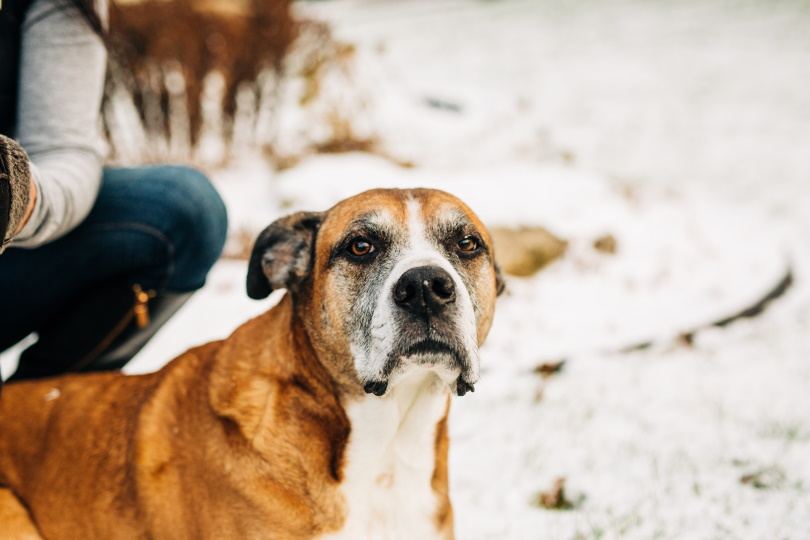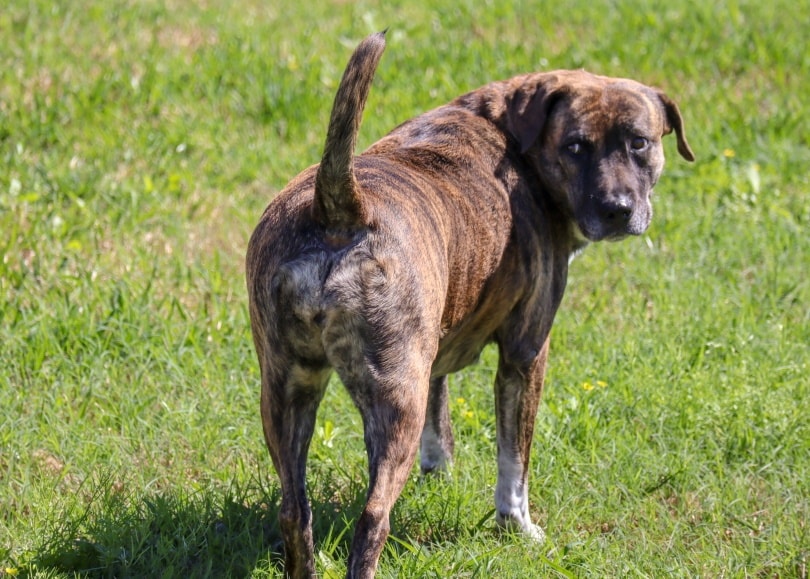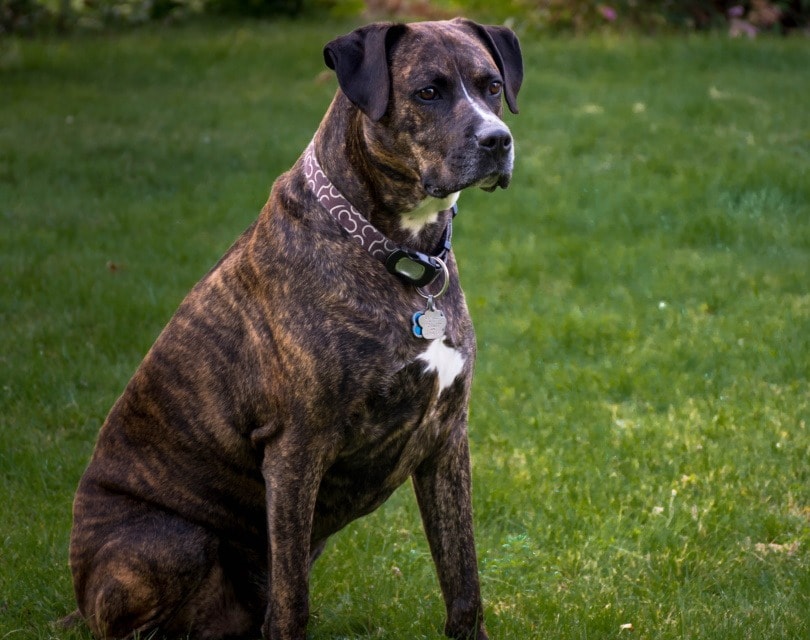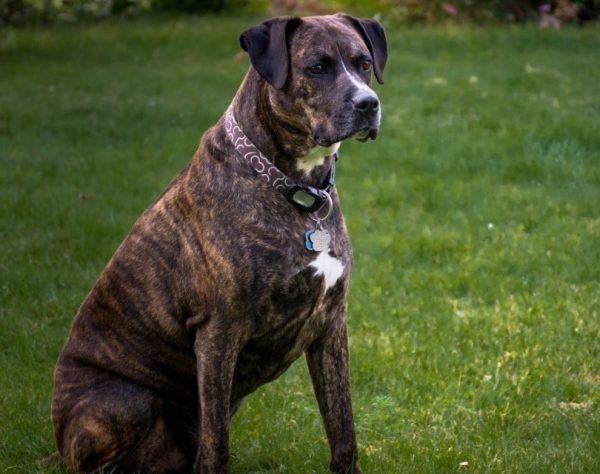Click Below to Skip Ahead
Also known as a Boxador, the Boxer Lab mix is not a purebred dog. They inherit traits from both parents, which can make predicting their temperament and appearance a bit difficult. After all, they can inherit any trait from either parent.
However, these dogs do have some specific traits most of the time. They must either take after the Boxer or Labrador Retriever parent. We’ll attempt to draw some conclusions in this article, though you should understand that puppies can vary widely even in the same litter.
Breed Overview
Height:
23-25 inches
Weight:
50-110 pounds
Lifespan:
10-12 years
Colors:
Black, Brown, White, Brindle
Suitable for:
Large, active families
Temperament:
Active, Friendly, People-Pleasing
Generally, these dogs make excellent but active family pets. They are best for families that like to go on adventures and partake in strenuous activities. They love to run, fetch, and participate in canine sports of all sorts. They aren’t a dog for someone that is primarily looking for a cuddle buddy. While they do cuddle, they typically only do this after they’ve been running around for an hour or so.

Boxer Lab Puppies

Boxer Labs can be challenging to find, as they are not as popular as purebred dogs. They aren’t as widely known as other dogs, so few people look to adopt them. However, a few breeders breed these dogs, though it is usually on the side and not their primary breed. You may be able to find one in your area.
Alternatively, you can sometimes find some puppies at rescues. These dogs tend to be happy accidents, which means they are often unwanted and turned over to the local shelter. You may be able to find this breed if you keep an eye on your local shelter and other rescues. However, statistically, the odds of this exact mixed breed showing up are slim.
When you bring home a Boxer Lab, be ready to have a friendly and loving dog by your side. They are very energetic dogs, so make sure they have plenty of space to run around in. With enough mental and physical stimulation, they’ll grow into happy dogs.

Temperament & Intelligence of the Boxer Lab Mix
Usually, these dogs are pretty friendly. They are very people-oriented and love to be around their family and strangers alike. Most of them are pretty friendly towards strangers. They can be pretty good with children as long as they are socialized early. Due partially to their high activity level, they are pretty playful. They enjoy just about any game, including fetch, water retrieval, and disc catching.
These dogs are well-known for getting along with other pets, as long as they are socialized correctly. They are usually excellent with other dogs, though they aren’t known for getting along with smaller pets. Their high prey drive often means that they will chase just about everything that runs. This means cats, rabbits, and other small pets.
The Boxer Lab mix is pretty happy and content most of the time. They aren’t challenging to take care of as long as their needs are met. Generally, they are pretty well behaved inside and outside alike. They’re eager-to-please and generally enjoy listening to their people.
They are pretty intelligent. This makes them pretty easy to train. However, it also means that this mixed breed needs regular mental stimulation. If they are not kept entertained, they are prone to destructive and problematic behavior. They will find ways to entertain themselves, which often causes them to get into trouble.
The best ways to keep them entertained involve obedience training, dog sports, and puzzle toys. If you’re going to be gone for an extended period, puzzle toys allow you to keep your dog entertained while you are away. However, you shouldn’t leave a Boxador alone for more than a few hours regularly due to its people-oriented nature. They need regular interaction to stay happy and healthy.

Are These Dogs Good for Families? 👪
For families with lots of children, these dogs can make good family dogs. They thrive the most in active, large families that will keep them entertained. Due to their high exercise and mental stimulation, they require quite a lot of care and attention. This is best accomplished in larger families, with multiple people to look after the dog.
These canines are pretty good with children as long as they are entertained early. Due to their larger size, they aren’t likely to get injured by children, which reduces the likelihood of fear and aggression on the dog’s part. Most of the time, dogs are aggressive towards children due to their fear. Children can be pretty unpredictable, and some smaller dogs may be fearful. Because the Boxador is so large, they are generally not fearful of children.
However, they still need regular socialization with children to get along with them. Puppies that grow up with children are typically just fine interacting with them. However, older dogs that haven’t spent much time around children may be a bit unsure.
Families that adopt this dog need plenty of extra time and attention when compared to other dogs. For this reason, they are not best for families that are gone for much of the day. Instead, we recommend them for families that are active but not so busy that they don’t have a few hours a day to dedicate to these dogs.
Does This Breed Get Along with Other Pets? 🐶 😽
This breed is excellent with dogs in most cases. Their friendly, playful nature makes them a perfect match for similar dogs. However, older, laidback dogs may find their constant ask to play a bit annoying.
The Boxer Lab mix does not have any territorial tendency, which allows them to get along with most dogs quickly. This is even true for dogs of the same gender.
However, you still need to socialize these dogs from an early age to understand how to interact with other dogs. Otherwise, their social skills may not be up to par, which can cause problems when they do interact with other dogs. We recommend puppy classes, which should fulfill their need for socialization and mental stimulation.
When it comes to other animals, these dogs usually aren’t a good mix. They have a decently high prey drive and will chase just about everything. This includes cats, bunnies, ferrets, and other small pets. This isn’t something that you can train out of them. They may act perfectly fine with a cat for years, only for their hunting instincts to kick in one day and lead to disaster. We do not recommend ever allowing these dogs to be alone with a cat or other small animal. You don’t know when their instincts may kick in.

Things to Know When Owning a Boxer Lab Mix:
Food & Diet Requirements 🦴
For the most part, these dogs don’t have any particular dietary needs. They are large and active, so they may need more calories than you would initially expect. However, this doesn’t necessarily mean that you should feed them plenty of extra. Instead, base their food amounts on their body condition. If they are a bit on the skinnier side, they may need some extra calories
These dogs are typically very food-driven, so they tend to overeat. Obesity can cause serious problems, especially since they are already prone to joint issues. Instead, two or three carefully measured meals a day are often sufficient.
You also need to be very careful when feeding your puppy. Both of the Boxador’s parent breeds are large and prone to hip dysplasia. This condition typically occurs when the hip joint doesn’t grow properly. The ball and socket of the joint end up misaligning, causing extra wear. Often, this leads to arthritis at an early age.
How you feed your puppy has a significant effect on how they grow. If they are fed too much, they will grow faster than they naturally should, which will lead to severe problems with their joints. For this reason, you should avoid overfeeding puppies. It is common for puppies to act hungry all the time, especially when they are as food-driven as this breed.
Exercise 🐕
The Boxer Lab mix needs a lot of exercises – and we mean a lot. These are one of the most active dogs around. They are very high-energy, so they should only be adopted by active families. They are not going to sit around and cuddle all day. The most they’ll lay around is for a few minutes after each exercise session. This is especially true when they are puppies, as they are typically more hyperactive when younger.
These dogs benefit from a backyard that they can run around in. However, they are highly people-oriented, so don’t expect them to get in all their exercise simply by putting them in a fenced-in yard. Instead, you’ll need to be next to them, “helping” them exercise. They enjoy just about any canine game out there, including fetch, retrieval, coursing, and just about everything else.
If you like to run or hike, this dog is highly suitable. However, you should aim to keep their exercise low-impact for the first two years while their hips are still forming. This will help prevent hip dysplasia later on.
Never force your dog to exercise, especially as a puppy. Puppies are prone to growing pains and can often not perform as athletically as an adult. They may be a bit hyperactive, but that doesn’t mean you should force them to exercise. Short, frequent exercise sessions are often best for puppies. A quick game of fetch in the backyard a few times a day may be all the time they need to stay healthy and worn out.

Training 🎾
These dogs are brilliant and eager to please. This makes them generally easy to train. They can quickly learn commands and usually don’t mind listening to them when the time comes. They are not prone to any behavioral problems, except for occasional bouts of separation anxiety. You must teach your puppy how to be alone from an early age so that they are comfortable without anyone else around.
Without the proper treatment early on, your puppy can quickly revert to nervous behaviors when left alone. This can cause destructive behaviors and barking, which many dogs find anxiety-relieving. Chewing is often a big problem among dogs with separation anxiety.
These dogs are usually well-behaved, especially when they are adequately trained. However, they are prone to destructive behaviors if their needs aren’t met. You should ensure that your dog is adequately exercised and mentally stimulated. A bored and hyperactive dog will often look for things to do, including chewing, getting into cabinets, and similar problem behaviors.
The Boxador is also quite slow to mature, so they tend to stay hyperactive and “puppy-like” for longer than you would imagine. For this reason, you should plan on being incredibly patient and expect puppy behaviors from them for a while. These dogs don’t mature as quickly as other dogs, so they don’t “calm down” quite as early.
Grooming ✂️
The Boxador doesn’t have high grooming needs. Their coat is usually short and dense. They don’t need regular trimmings or anything of that sort. They do shed moderately year-round, so we recommend a regular brushing session weekly. This will help keep them clean and remove loose hairs that would end up on your floor otherwise.
They may shed more during season changes. This is often called “blowing their coat.” During these periods, you’ll need to increase your dog’s brushing sessions to once a day. Once their coat stops shedding quite as much, you can decrease the sessions back to once a week.
These dogs won’t need a bath unless they get dirty. They keep themselves cleaned quite easily, except when they roll in mud or swim in swampy water. We recommend keeping their bathing to a minimum, or you may end up stripping them of their natural oils. This can cause problems on their skin and coat, such as irritation.
They will also need their ears and nails taken care of. Like all dogs, you should plan on trimming their nails as needed. You can do this yourself at home or visit a groomer. Many of them provide walk-in appointments for nail clippings that are very inexpensive. Their ears are typically not in need of regular care. However, they can get dirty, which can lead to ear infections. Keep your eye out for dirt and debris in the ear and clean them with a wet cotton ball when necessary.

Health and Conditions ❤️
As a mixed breed, this dog is typically pretty healthy. They inherit genes from a vast gene pool, which means that they are less likely to inherit genetic conditions. However, that doesn’t mean that they aren’t entirely healthy. They are still prone to a few problems.
The most severe problem that the Boxer Lab mix often develops is hip dysplasia. This is a condition that causes pain and inflammation in the dog’s hip joint, which can lead to lameness and arthritis. Typically, it is caused by excess wear and tear. This can be due to genetics alone, though it is often caused by improper feeding and exercising when they are puppies.
This condition isn’t completely preventable, but taking care of your puppy properly can go a long way.
Because this mixed breed is likely to be large, they may be at an increased risk of bloat. This is a life-threatening condition that comes on suddenly. For reasons we don’t completely understand, the dog’s stomach begins to fill up with gas, which can cause the stomach to expand and cut off circulation to surrounding body parts. Within only a few hours, the dog goes into shock and eventually dies.
Male vs. Female
There is no significant difference between males and females. Because this breed is so diverse, it is difficult to tell similarities and differences between genders. While males may sometimes be larger, this isn’t always true. Their weight can vary greatly, and it isn’t always tied to gender.
3 Little-Known Facts About the Boxer Lab Mix
1. They are incredibly active.
These are some of the most active dogs on the planet. Their parents were bred to work all day, so this mixed breed is often ready to do the same. For this reason, they are only recommended for active families that are willing to commit an hour or two a day to their exercise.
2. Boxer Lab Mixes are pretty intelligent.
Boxer Lab mixes are one of the more intelligent dogs out there. For this reason, they can quickly learn most commands. They also require quite a bit of mental stimulation, though. This is best accomplished through obedience training or canine sports. Often, dogs will outgrow regular obedience training at some point and then must continue to be stimulated through other means.
3. These dogs vary quite a bit.
Because they are a mixed breed, these dogs vary quite a bit. They can inherit any traits from either of their parents. Some may act like Boxers but look like Labs. Others may be somewhere in between.

Final Thoughts
The Boxer Lab mix can be a great family pet for large, active families that are looking for a dog that can keep up with them. This mixed breed is highly active and requires a lot of exercise, making them inappropriate for families that would rather cuddle on the couch. You should expect to exercise this dog for hours each day.
Due to their high intelligence and people-pleasing nature, these dogs are pretty trainable. However, they also require a lot of mental stimulation. Plan on meeting this need through obedience training, puzzle toys, and canine sports, or you may end up with a bored and destructive dog.
Overall, this is a solid family dog as long as you know exactly what you’re getting into when you adopt them.
- See also: 10 Best Dog Beds For Boxers
Featured Image Credit: Paul Donald, Shutterstock









